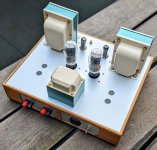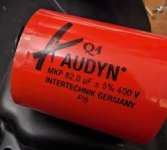Also a shoutout to Bottlehead. Because of their pictures. I found out I could put my output transformer under my plate choke with the laminates in line. I would never have done that without seeing it. I would have tought it would induce something unwanted. But like I said...quietest amp ever.


No fear of highlighting the OPTs for reduced induction 👍 Might steal. Already a fan of brass end bell hardware.
Nice Bas! I am a bit surprised that the plate still looks relatively flat, it has a lot of weight on it. How thick is it? Did you check how hot after a couple of hours playing?
Yes, this amp has a lot going for it: DHT, very good PS throughout (VCCS for cathodes, choke input), DC coupling with low source resistance. Nice indeed!
Most of the iron I still have at my disposal I collected back in NL, before 2012. Throughout the last years I have been slowly putting them to use, and even though it may not always be the best quality I feel very happy to finally see them in action!
And you are already working at the next one while the boys are listening their tunes? 🙂
Yes, this amp has a lot going for it: DHT, very good PS throughout (VCCS for cathodes, choke input), DC coupling with low source resistance. Nice indeed!
Most of the iron I still have at my disposal I collected back in NL, before 2012. Throughout the last years I have been slowly putting them to use, and even though it may not always be the best quality I feel very happy to finally see them in action!
And you are already working at the next one while the boys are listening their tunes? 🙂
The weight is all near the sides. 2mm aluminium. No part on the top plate apart from the tubes are over 49 degrees celcius.
Ofcourse! 😀And you are already working at the next one while the boys are listening their tunes?
Those are actually the plate chokes. The output transformers are right below it. I was afraid if I put them near the psu chokes and filament transformers in the back there would be hum.No fear of highlighting the OPTs
What a good looking and successful project!
When I design and build, I often measure just a few things:
DC voltages and currents of the tubes; then put a scope probe on it and look for oscillation.
Then I connect a speaker, look again for oscillation.
After that, I am far too excited to do full measurements, I can't wait to just listen, listen, listen.
Only then do I test the harmonic distortion, intermodulation distortion, power output, clipping, square wave response to 1kHz and 10kHz, frequency response, damping factor, weight, power draw, power factor, etc.
When I design and build, I often measure just a few things:
DC voltages and currents of the tubes; then put a scope probe on it and look for oscillation.
Then I connect a speaker, look again for oscillation.
After that, I am far too excited to do full measurements, I can't wait to just listen, listen, listen.
Only then do I test the harmonic distortion, intermodulation distortion, power output, clipping, square wave response to 1kHz and 10kHz, frequency response, damping factor, weight, power draw, power factor, etc.
I wish I had measuring equipment. I gave away a scope because I did not know how to use it.
Last edited:
Bas Horneman,
I was never in the Netherlands, if I had been, I would have taught you to operate that scope, and a few lesser known scope tricks.
There is an old statement: "Seeing is Believing".
Then Eroll Garner, the blind jazz pianist wrote a tune: "Feeling is Believing".
If you can find a copy of that song, you will probably find that: "Hearing is Believing".
Nice amplifier!
I was never in the Netherlands, if I had been, I would have taught you to operate that scope, and a few lesser known scope tricks.
There is an old statement: "Seeing is Believing".
Then Eroll Garner, the blind jazz pianist wrote a tune: "Feeling is Believing".
If you can find a copy of that song, you will probably find that: "Hearing is Believing".
Nice amplifier!
Lol, of course. Parafeed. I'll pretend they're OPTs and steal the idea regardless.Those are actually the plate chokes.
Bas,
https://www.diyaudio.com/community/attachments/pxl_20240215_113334892-mp-edit-jpg.1274470/
Put 10k resistors further away from the Audyn capacitor.
Each resistor dissipates 4W (total 12W), so acts like a heater.
The 25k "pack" also dissipates 9W.
I know, that there is not enough space between 38uF Kemet and (very fat) 82uF Audyn, but if you raise resistors "higher" (closer to the bottom) and try to make its horizontal, the heat distribution will be better.
https://www.diyaudio.com/community/attachments/pxl_20240215_113334892-mp-edit-jpg.1274470/
Put 10k resistors further away from the Audyn capacitor.
Each resistor dissipates 4W (total 12W), so acts like a heater.
The 25k "pack" also dissipates 9W.
I know, that there is not enough space between 38uF Kemet and (very fat) 82uF Audyn, but if you raise resistors "higher" (closer to the bottom) and try to make its horizontal, the heat distribution will be better.
I have added heat reflecting tape on the Audyns. https://www.heatshieldings.com/nl/dei-reflect-a-gold-38cm-x-91m.html
But now that all is working. I'll see what I can do.

But now that all is working. I'll see what I can do.
Attachments
Last edited:
C2 added. Apparently choke input with solid state is pretty rough on L1. I could feel vibration. After c2....very light vibration only.

Quote: "I never met a 2A3 amplifier that I did not like" Sound Practices Magazine; I can not remember the Author who wrote that.
30kg
A 10kg per watt machine!
Very nice looking though. Congratulations.
- Home
- Amplifiers
- Tubes / Valves
- Building parafeed EL84 DC 2A3 amp

